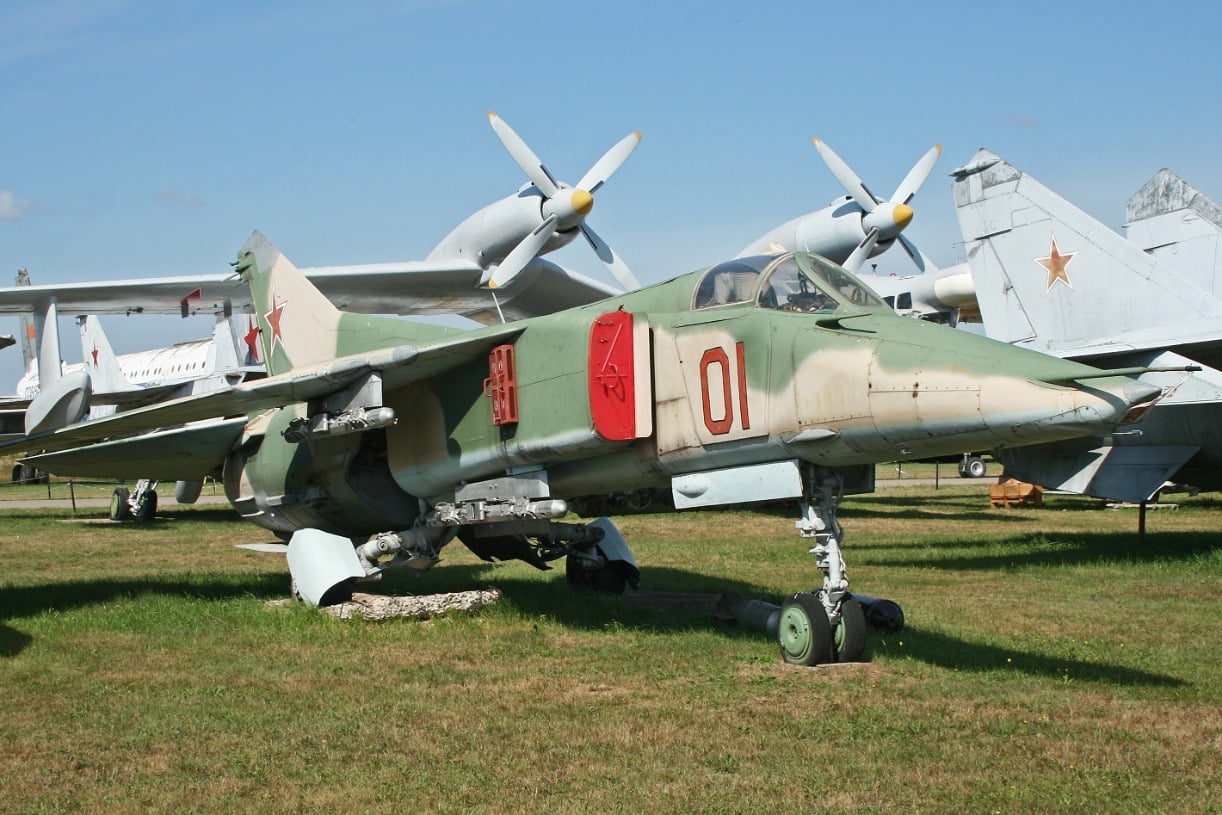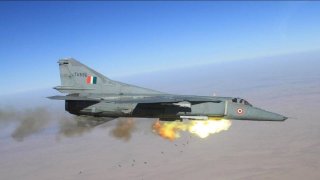Russia's MiG-27 Flogger Fighter: What You Need to Know
The Mikoyan MiG-27 “Flogger,” a variant of the MiG-23, was a Soviet ground-attack aircraft featuring a unique design with variable sweep wings for versatility in speed and control.
Summary and Key Points: The Mikoyan MiG-27 “Flogger,” a variant of the MiG-23, was a Soviet ground-attack aircraft featuring a unique design with variable-sweep wings for versatility in speed and control.
-It shared the MiG-23 airframe but had a distinct, simplified nose cone for its role in low-altitude air-to-ground missions.
-Built for rugged use, it featured heavy-duty landing gear for operations from rough airfields.
-Though armed with a powerful Gryazev-Shipunov GSh-6-30 cannon and capable of carrying a large array of ordnance, the MiG-27 wasn’t particularly fast and saw limited combat, primarily used during the Soviet invasion of Afghanistan. It has since been retired.
Russia's MiG-27 Flogger Fighter, the Details
I sometimes have trouble keeping Soviet aircraft straight. Whereas American aircraft, to my eye, look distinct from one to the next, there is something so uniform about the Mikoyan and Sukhoi aircraft lines. Maybe I’m just less familiar with foreign aircraft lineups.
Let’s take a closer look at one of the MiG fighters I have trouble discerning from the rest of the family – the MiG-27, NATO reporting name “Flogger.”
Introducing the MiG-27
If there’s an easy way to identify the MiG-27, it’s the sweep-wings. Much like the more famous (and easier to recognize) F-14 Tomcat, the Flogger features wings that can sweep forward to increase drag and lift for increased control, or sweep back for decreased drag and lift, as well as greater speeds.
The MiG-27 was derived from the similar-looking MiG-23. But whereas the MiG-23 was widely exported, fewer customers were interested in the MiG-27. The exceptions were India, Sri Lanka, Ukraine and Kazakhstan, who formerly operated the MiG-27. But for the most part, the MiG-27 was a domestically flown Soviet and later Russian aircraft.
The MiG-27 adopts the MiG-23 airframe but features a modified nose cone. Additionally, it does away with the MiG-23’s variable intake ramps and exhaust nozzles. This is because the MiG-27 was designed to fly low-altitude air-to-ground missions and needed a simple, light configuration. To facilitate operations from shoddier airfields, the MiG-27 was also outfitted with heavy-duty landing gear.
The MiG-27 did not see much action. The only time the Soviet Union deployed it was during the late stages of the Afghanistan invasion. Commonly understood as a strategic misstep, the Soviet invasion of Afghanistan has been held up as an analog of the modern invasion of Ukraine – an aggressive action that made Moscow a pariah in the international community.

The Specifications of the MiG-27
The MiG-27 was a single-seat jet with one Tumansky R-29 B-300 afterburning engine capable of providing 17,600 pounds of thrust dry, or 25,400 pounds of thrust with the afterburner engaged. Yet the jet’s thrust-to-weight ratio was just 0.62, and as a result, the MiG-27 was not particularly fast, hitting just Mach 1.09 at sea level. But the jet could climb respectably, hitting 39,000 feet per minute and needing barely 75 seconds to hit its service ceiling of 46,000 feet.
The attack aircraft was, as you might expect, well-armed, with one Gryazev-Shipunov 6-30 rotary cannon and seven hardpoints. The hardpoints could carry a wide variety of rockets, missiles, and bombs. The jet’s max takeoff weight was about 46,000 pounds, whereas the empty weight was 26,000 pounds, meaning the MiG-27 could heft plenty of ordnance.
Today, the MiG-27 is completely retired.
About the Author: Harrison Kass
Harrison Kass is a defense and national security writer with over 1,000 total pieces on issues involving global affairs. An attorney, pilot, guitarist, and minor pro hockey player, Harrison joined the US Air Force as a Pilot Trainee but was medically discharged. Harrison holds a BA from Lake Forest College, a JD from the University of Oregon, and an MA from New York University. Harrison listens to Dokken.
Image Credit: Creative Commons.


